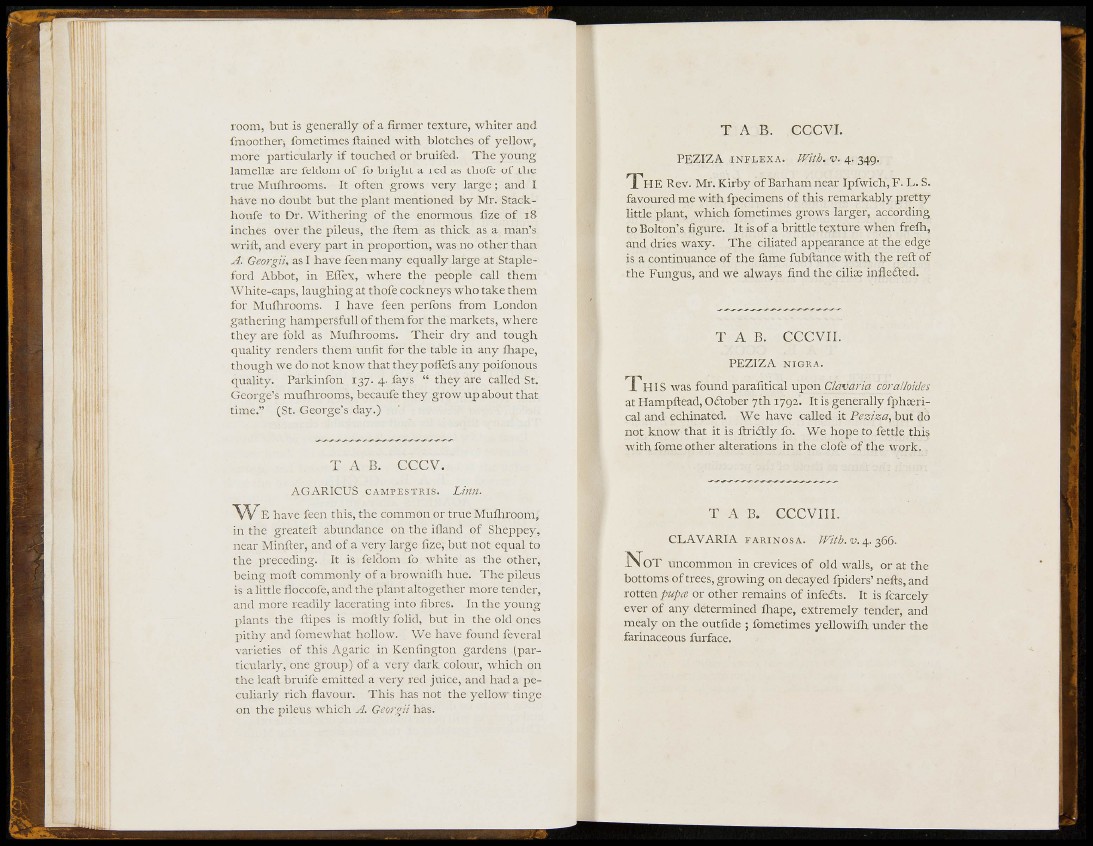
msmi
room, but is generally of a firmer texture, whiter and
fmootheri fometimes ftained with blotches of yellow,
more particularly if touched or bruited. The young
lamelte are feldom of fo bright a red as thofe of the
true Mullirooms. It often grows very large; and I
have no doubt but the plant mentioned by Mr. Stackhoufe
to Dr. Withering of the enormous fize of i8
inches over the pileus, the item as thick as a man's
wrift, and every part in proportion, was no other than
Georgit, as I have feen many equally large at Stapleford
Abbot, in EiTex, where the people call them
White-caps, laughing at thofe cockneys who take them
for Muflrrooms. I have feen perfons from London
gathering hampersfull of them for the markets, where
they are fold as Muflirooms. Their dry and tough
quality renders them unfit for the table in any fliape,
though we do not know that they poffefs any poifonous
quality. Parkinfon 137. 4. fays " they are called St.
George's muflirooms, becaufe they grow up about that
time." (St. George's day.)
T A B . CCCV.
AGARICUS cAMPESTpas. Linn.
W E have feen this, the common or true Mufliroom,
in the greateft abundance on the ifland of Sheppej^,
near Minñer, and of a very large fize, but not equal to
the preceding. It is feldom fo white as the other,
being moil: commonly of a browniflr hue. The pileus
is a little floccofe, and the plant altogether more tender,
and more readily lacerating into fibres. In the young
plants the ftipes is moflly folid, but in the old ones
pithy and fomewhat hollow. We have found feveral
varieties of this Agaric in Kenfington gardens (particularly,
one group) of a very dark colour, which on
the leaft bruife emitted a very red juice, and had a peculiarly
rich flavour. This has not the yellow tinge
on the pileus which yi. Georgii has.
T A B . CCCVI.
PEZIZA INFLEXA. With. V. 4. 34.9.
T h e Rev. Mr. Kirby of Barham near Ipfwich, F. L. S.
favoured me with fpecimens of this remarkably pretty
little plant, which fometimes grows larger, according
to Bolton's figure. It is of a brittle texture when frefli,
and dries waxy. The ciliated appearance at the edge
is a continuance of the fame fubftance with the reft of
the Fungus, and we always find the cilias inflefted.
T A B. CCCVII.
P E Z I Z A NIGRA.
T h i s was found parafitical upon Clavaria cor a!hides
at Hampflead, Oftober 7th 179a. It is generallj^ fphaerical
and echinated. We have caUed it Peziza, but do
not know that it is ftriitly fo. We hope to fettle this
with fome other alterations in the clofe of the work.
T A B. CCCVIII.
C L A V A R I A FARINOSA. 366.
N O T uncommon in crevices of old walls, or at the
bottoms of trees, growing on decayed fpiders' nefts, and
rotten pupa or other remains of infefts. It is fcarcely
ever of any determined fliape, extremely tender, and
mealy on the outfide ; fometimes yellowifli under the
farinaceous furface.
m